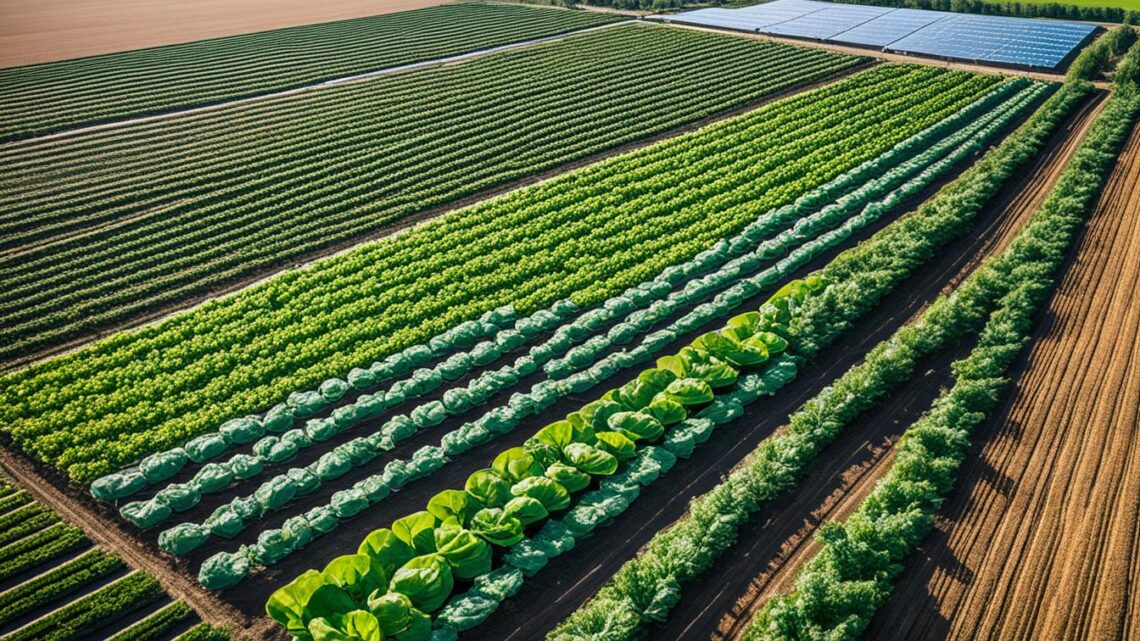
Did you know our food system is harming the environment and releasing a lot of greenhouse gases? But, more farmers are now using sustainable farming methods that help the planet and people. Let’s explore what sustainable farming is and how it can make our future healthier.
Sustainable farming means working with nature to grow more food with less harm to the environment. It keeps natural resources safe, increases plant and animal diversity, and makes life better for everyone. By using regenerative farming, farmers can lower their carbon emissions, improve soil health, fight pests better, and make more money.
Embrace Regenerative Agricultural Practices
Sustainable farming has changed a lot, with regenerative agriculture leading the way. This method focuses on making soil healthy, increasing plant variety, and lowering harm to the environment.
Crop Rotation and Biodiversity
Switching crops and using many types of plants helps farming in big ways. By mixing different plants together and changing what grows in the same spot often, soil gets healthier and pests are kept under control. This approach makes farms more like natural areas, which helps fight pests and diseases without using bad chemicals.
Cover Crops and Perennials
Using cover crops and perennials is key in regenerative farming. Plants like clover, rye, or hairy vetch protect and improve soil. They stop soil from washing away, add nutrients, and fight weeds, which means less need for harmful chemicals. These plants keep soil alive all year, helping it work better and supporting life underground, which is good for nutrients and pests.
| Regenerative Agriculture Practices | Benefits |
|---|---|
| Crop Rotation and Intercropping | Improved soil health, enhanced biodiversity, and natural pest control |
| Cover Crops and Perennials | Erosion prevention, nutrient replenishment, and reduced need for synthetic inputs |

By using these methods, farmers can create farms that are strong, productive, and good for the planet. These farms help the land and the people who live nearby.
Minimize Environmental Impact
Farmers are key in reducing the environmental harm from farming. They can do this by cutting down on tillage and using pest management strategies.
Reduce or Eliminate Tillage
Old-school plowing harms the soil, leading to erosion and releasing carbon. No-till farming puts seeds into the soil without disturbing it. This keeps the soil healthy, cuts down erosion, and helps the environment.
Using these methods helps fight climate change and keeps the ecosystem balanced.
Integrated Pest Management
Integrated pest management (IPM) fights pests with various methods, not just chemicals. It’s good for the environment and supports helpful insects. Crop rotation and cover crops also help control pests without chemicals.
These sustainable farming ways make for a healthier ecosystem. They lower your carbon footprint and protect your land for the future.
Sustainable Farming: A Holistic Approach
Sustainable agriculture is key for a healthier future. It offers benefits for the environment, economy, and society. By using methods like conservation tillage and crop rotation, you can make food more secure and save resources. These practices also help fight climate change and keep the planet healthy for future generations.
For a better future, we need big policy changes, more research, and incentives. We also need community support to make our food system sustainable. Sustainable farming is about solving big problems like saving the environment, making money, and improving life quality in communities.
Working together, we can make a big difference. By choosing sustainable farming, you help grow food responsibly and protect resources for the future. This is not just a choice, but a must for a good and fair future.
With sustainable agriculture, we can build a food system that’s good for the planet, the economy, and people. This way, your community and the earth will flourish for many years.



